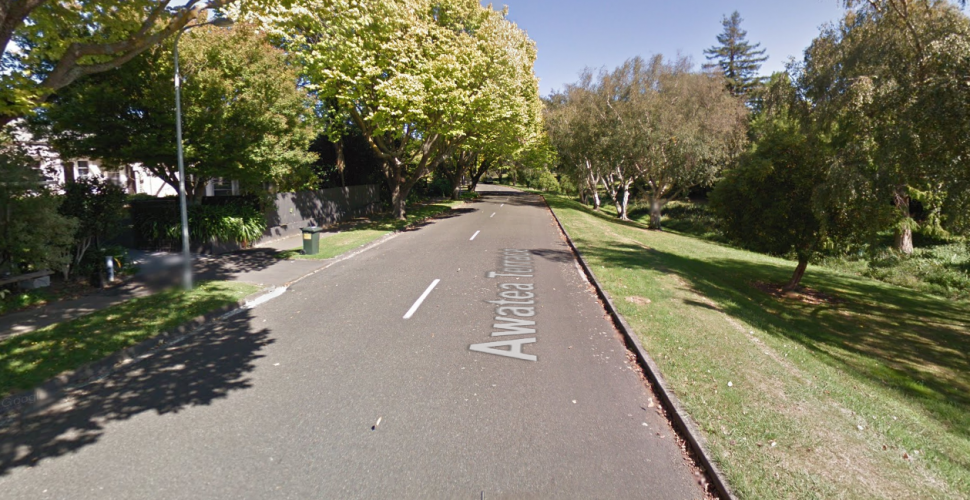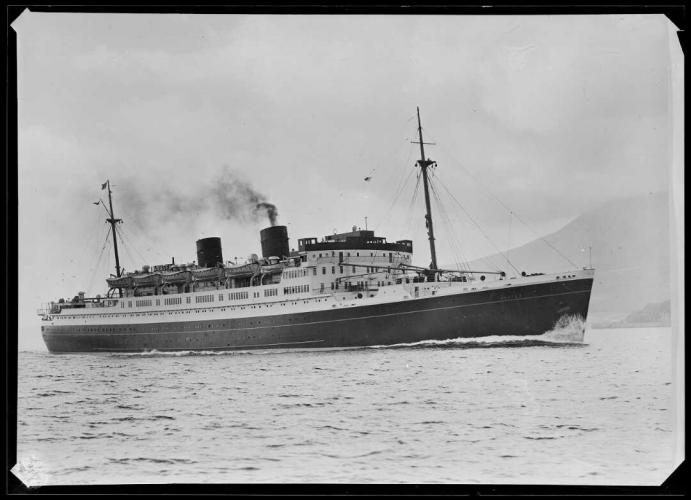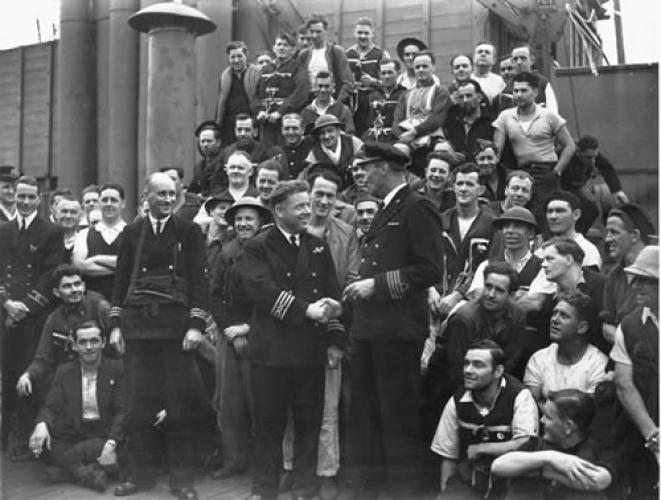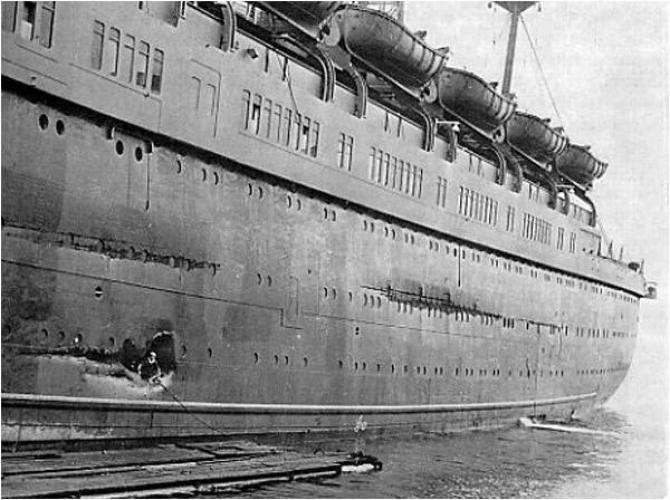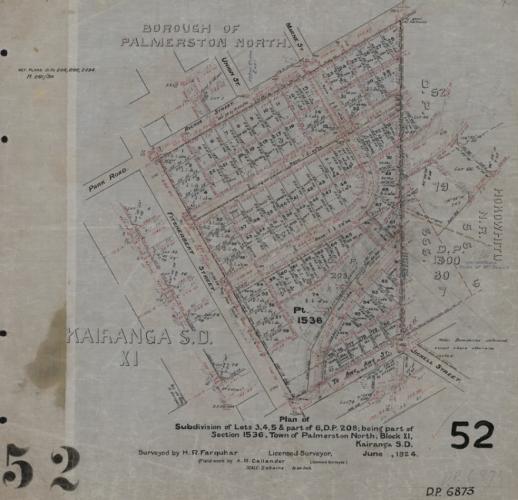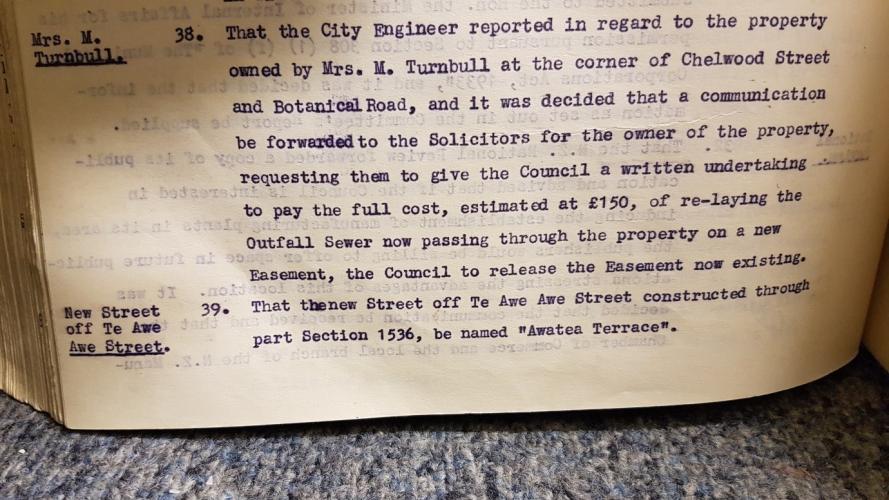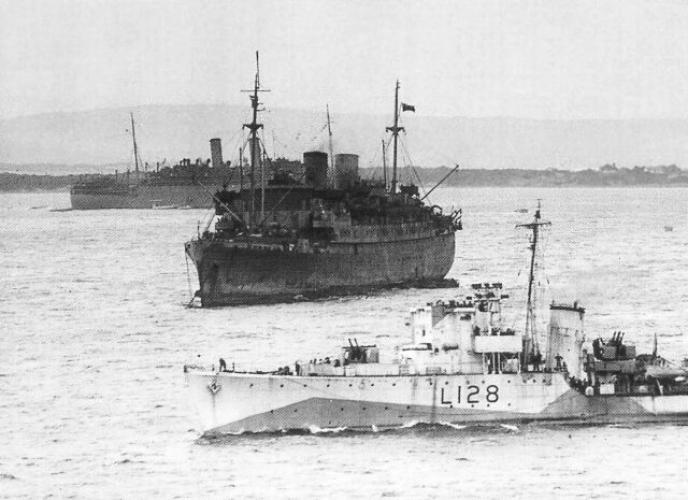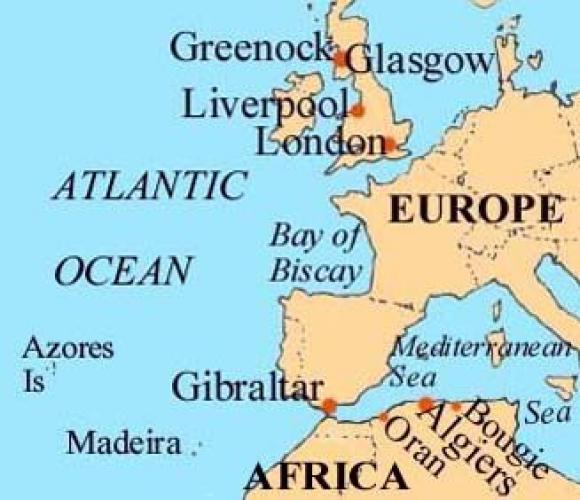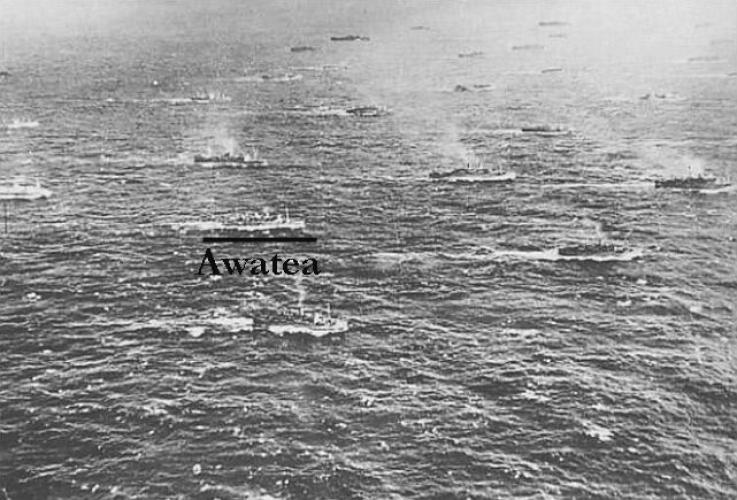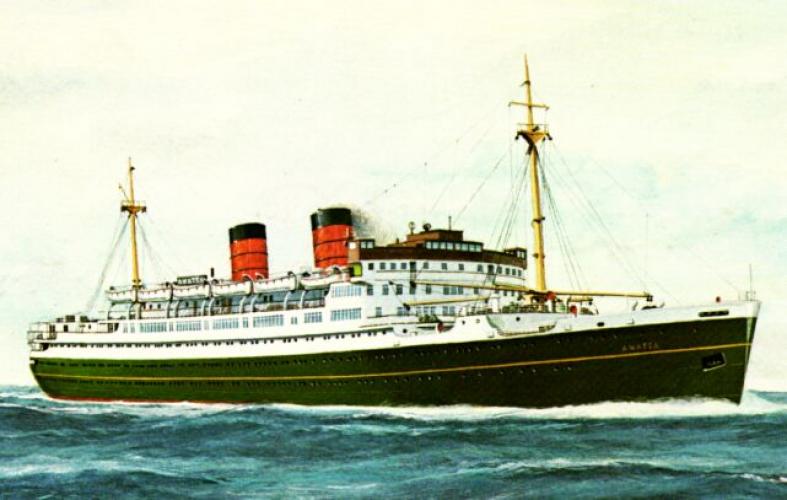127 Awatea Terrace Palmerston North, TSS Awatea 3 days before being sunk
Reason for the name
The reason for naming this street is believed to be a tribute to the naval ship Her Majesty's Transport Awatea a Māori term meaning “bright pathway”,. HMT Awatea was a troopship used in World War II, that was actually a converted Ocean Liner, TSS Awatea, built for the Union Steam Ship Company of New Zealand. She was sunk by airplanes after putting up a heroic fight and delivered the last wave of specialized assault troops to the beach in Algeria for Operation Torch.
About Awatea Terrace
The area surrounding Awatea, was originally part of Section 1536 in the Kairanga Survey District, a large, semi-rural area. Partitioning of this large section began in the 1880s, and the area on the corner of Fitzherbert Avenue and Te Awe Awe Street is shown as a Borough Reserve in 1895. The first planned subdivision and roadway running off Te Awe Awe Street was surveyed by H R Farquhar in 1923. Finalised plans for the building of Awatea Terrace were handed to Council in June 1924, with the first part of the street being built in 1925.
Being considered a minor side-street of Te Awe Awe Street, it was not until over a decade later that the naming of the street was put before the Council. Town Clerk J R Hardie suggested it be named after the newly constructed TSS Awatea, as his son was serving as purser on the ship’s Wellington to Sydney run at the time. This suggestion was accepted by Council on 15 June 1939, with the first allotments being offered in October 1938, and the second stage connecting with Marne Street was completed in 1940
Awatea Terrace lies near the cross roads between Fitzherbert Avenue, Te Awe Awe Street and Manawaroa Street. The roadway has 9 residential houses and has a northern entrance via Marne Street which loops in a dog-leg south until linking up with Te Awe Awe Street. Nearby amenities to the west include Fitzherbert Park, Manawaroa Park, Victoria Esplanade, Ongley Park and the Manawatū River Pathway. The Awatea Reserve runs along the entire west side of the roadway, with Wallace Park, Hokowhitu Lagoon and Fitzherbert Bridge lying to the south.
Author: Evan Greensides, Heritage Assistant for Palmerston North City Libraries & Community Services.
History of HMT Awatea
Facing considerable competition from larger, faster US ships on the trans-Tasman route from Auckland to Sydney in the mid-1930s, the Union Steam Ship Company sought to gain back market share with the development of the Awatea. Conceived at the company’s headquarters in Wellington, the tender to build Awatea was awarded to Vickers-Armstrongs Ltd. From the first keel plates being laid on 14 June 1935, the ship's construction took 8 months, being christened by Lady Beldisloe before being launched at Barrow-on-Furness. At 527 feet long 13,500 gross tonnage, Awatea created 24,000 horsepower and managed to reach 22.5 knots, the speed of her nearest competitors, running on only four of six total boilers during test runs before being handed over to The Union Steam Ship Company on 28 July 1936?.
There is no doubt that Awatea’s USSCo’s designers had done a unique job and they had managed to design a ship that was pure maritime perfection! Her 545 ft long green hull, red boot topping with a thin gold band surrounding her slender and perfectly balanced hull was designed for speed and superior stability. In addition, she had a rolled bow, which was gently raked (rather than the knife-edge bows such as the Monowai). Awatea’s hull was in total balance with her elegant low slung long superstructure, topped with two perfectly raked red and black funnels, as well as her two tall raked masts, which made her look very much like a grand “Ocean Liner,” be it on a smaller scale!
Another factor was that her public rooms certainly matched the perfection of her exterior. Awatea featured some of the finest lounges imaginable and many of these were built on a grand scale indeed, especially considering she was designed to operate a two and a half day Trans-Tasman Express service from New Zealand to Australia and return, a voyage that would be at least one day shorter than any of her competitors! The truth is Awatea would have been perfect as a Trans-Atlantic Liner. During her far too short commercial life the TSS Awatea operated all her services with great dignity, as well as being known for a ship that broke a few nautical records!
After sailing to New Zealand and reaching Wellington, the Awatea was departed Auckland on her maiden voyage across the Tasman Sea to Sydney.
Under the captaincy of Captain Davey, the Awatea quickly gained a reputation for breaking records on voyages across the Tasman and for arriving in port on schedule. On 4 October 1937, the Awatea set the record for the Auckland to Sydney run with a time of 2 days, 7 hours and 28 minutes for the 1,281 mile journey, with an average speed of 23.1 knots, a record which would be retained for the next 24 years. During the summer of 1937 the Awatea took its only cruise around New Zealand, visiting Whangaroa, Bay of Islands and Great Barrier Island.
When the Second World War began in September 1939, the Awatea was undergoing an annual refit in Sydney. Maintaining her usual trans-Tasman service up until mid-1940, the ship was given a 4-inch deck gun to keep at bay any German raiders which looped through the Pacific Ocean at the time. After sister ship Niagra was lost on 19 June 1940 off Northland’s Bream Head, the Awatea was chosen to replace her on the trans-Pacific troop convoy route. After uplifting refugees from the Philippines, the Awatea made multiple voyages to Vancouver ferrying troops across the Pacific before the British Ministry of War Transport requisitioned her for service in Europe.
Converted into a full troop ship and painted entirely in grey, the Awatea departed Vancouver for her new deployment on 11 September 1941. There was to be a bad start, as the next morning the US tanker M E Lombardi rammed the Awatea off Vancouver Island in dense fog, sending her back for repairs. After nearly a full year of successful transports to various ports, disaster struck again. This time the Awatea rammed destroyer USS Buck on 22 August 1942 off the Newfoundland Banks, causing a depth charge to roll overboard and explode beneath the Awatea, causing significant damage. As a result, the Awatea spent a month in dock in Halifax being repaired before proceeding to Glasgow where she was converted to an infantry landing ship for use in the Allied landings in North Africa.
On November 8, 1942 the Awatea took part in Operation Torch, which was according to the war records, a successful Allied invasion of French North Africa. After landing some 3,000 commandoes near Algiers, the Awatea ferried more troops further east.
Then on the night of November 11, just off Bougie, the troops had disembarked and stores and equipment were being discharged when enemy aircraft attacked and dropped two bombs close by the Awatea. The attack was driven off by concentrated fire from the ships, but soon afterwards four bombers came in from seaward at low level. One aircraft was definitely shot down by gunners from the Awatea, and another was badly damaged by other ships. Having completed discharging, the Awatea was under heading for the sea when an attack by an unknown number of aircraft developed. With all her anti-aircraft armament firing the ship had proceeded about a mile when she was hit in Nos. 1 and 2 hatches by number of bombs, which set the fore end of the ship ablaze.
The helm was ordered hard-to-port with the object of beaching the ship should it be necessary. But then came two hits by torpedoes on the port side caused damage and flooding to the after engine room and put the fire fighting appliances out of action. One bomb, thought to be a dud, went through the officers' dining room and another struck into the fire raging in No. 2 hatch. One bomber hit by the ship's gunners crashed into the face of a cliff and then fell into the sea. Other aircraft were seen to have been hit but did not crash. All guns continued in action till the attack ceased. By this time the flooding of the engine-room had caused a list of nearly 40 degrees. The ship carried her way for a considerable time, but not sufficiently long to reach shoal water. Before she finally stopped an explosion in the ship was felt. It was thought to have been caused by the believed dud bomb detonating. The Awatea was now well ablaze from under the bridge to the bows. When the first bombs hit the ship both the steel hatch cover of Nos. 1 and 2 hatches were blown into the air, one landing on the starboard side of the bridge and. the other close to No. 4 hatch on the after deck. When this hatch cover was in flight one gunner mistook it for a dive-bomber and opened fire on it. Several near misses by bombs were observed, two of which shattered much of the forward first class passenger accommodation. The Awatea was stopped and blazing furiously when she was abandoned. The ship's medical staff evacuated the sick men from the hospital aft and the crew carried them and injured men to the boats.
The ship's company were taken off in the five remaining serviceable lifeboats, and a destroyer which placed herself alongside the starboard quarter. There was no sign next morning of the ship, as she had sunk in deep water. Everything possible for the comfort of the Awatea's personnel was done by the companies of several ships, but especially by those on board the Dutch liner MS Marnix van St Aldegonde that had been in the convoy. The MS Marnix van St. Aldegonde was a sister ship to the MS Johan van Oldenbarnevelt which brought many Dutch immigrants to New Zealand after the war.
The survivors taken aboard the Dutch ship who had been witnesses of another air attack which shook their ship with a number of near misses. The attack was beaten off by gunners. During the passage to England Captain G. B. Morgan, D.S.O., D.S.C., master of the Awatea, presented the master of the Netherlands ship with an illuminated address recording the appreciation of himself and his crew of the many courtesies and the great kindness shown them by the Dutch seamen in this the tercentenary year of the discovery of New Zealand by Abel Tasman.
After abandoning ship and being picked up by HMS Bicester and HMS Pentstemon, the crew counted themselves extremely lucky, with only four wounded and no fatalities. For his bravery, Captain G B Morgan was awarded the Distinguished Service Order (DSO) and Lloyd’s War Medal for Bravery at Sea, with 16 other crew members being recognised for their actions that day.
The Awatea successfully delivered countless New Zealand and Australian air trainees to Canada, as well as shipping some 2,000 Canadian troops to Hong Kong, and evacuated civilians from the Philippines and Singapore. In addition, she transported British airmen from the UK to India and carried several thousand Free Polish troops from India to South Africa and during these various missions the ship narrowly escaped German U-boat attacks in the North Atlantic.
During her short life at sea the Awatea steamed 576,132 miles, slightly more than half during peacetime, including 225 Tasman crossings. In her day the Awatea provided the “Acme of maritime speed and comfort”.
The Awatea was the only international merchant ship manned by an entirely New Zealand crew to take part in combat during World War II. Today, the Awatea lies in deep water off Cap Carbon in Algeria, North Africa.
The Trust acknowledges some history from Reuben Goossens.


